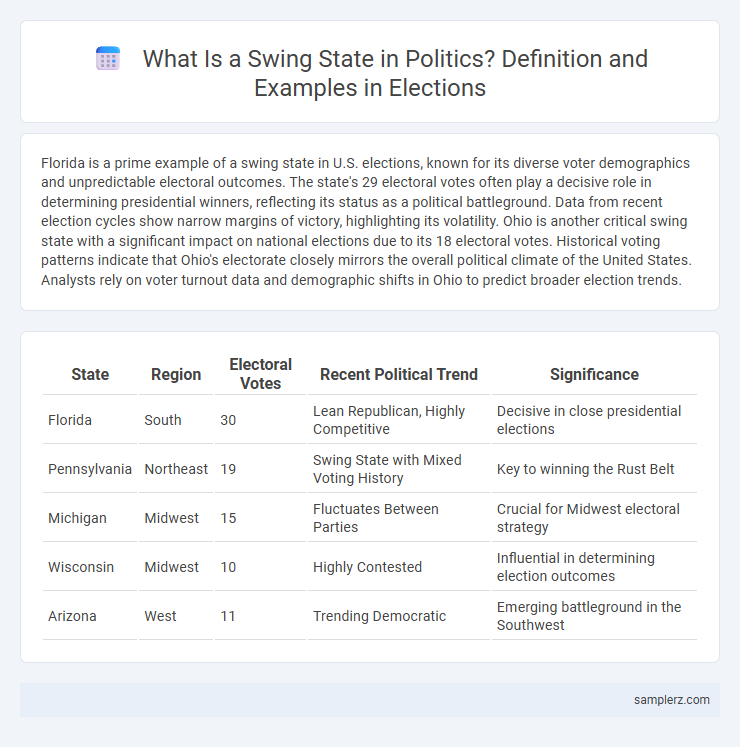Florida is a prime example of a swing state in U.S. elections, known for its diverse voter demographics and unpredictable electoral outcomes. The state's 29 electoral votes often play a decisive role in determining presidential winners, reflecting its status as a political battleground. Data from recent election cycles show narrow margins of victory, highlighting its volatility. Ohio is another critical swing state with a significant impact on national elections due to its 18 electoral votes. Historical voting patterns indicate that Ohio's electorate closely mirrors the overall political climate of the United States. Analysts rely on voter turnout data and demographic shifts in Ohio to predict broader election trends.
Table of Comparison
| State | Region | Electoral Votes | Recent Political Trend | Significance |
|---|---|---|---|---|
| Florida | South | 30 | Lean Republican, Highly Competitive | Decisive in close presidential elections |
| Pennsylvania | Northeast | 19 | Swing State with Mixed Voting History | Key to winning the Rust Belt |
| Michigan | Midwest | 15 | Fluctuates Between Parties | Crucial for Midwest electoral strategy |
| Wisconsin | Midwest | 10 | Highly Contested | Influential in determining election outcomes |
| Arizona | West | 11 | Trending Democratic | Emerging battleground in the Southwest |
Defining Swing States in U.S. Elections
Swing states, also known as battleground states, like Florida and Pennsylvania, play a pivotal role in U.S. presidential elections due to their unpredictable voting patterns and evenly divided electorates. These states often receive significant campaign attention and funding, as their electoral votes can determine the overall outcome. The fluctuating political preferences in swing states highlight the dynamic nature of American electoral politics and emphasize their importance in strategizing election campaigns.
Historical Overview of Swing States
Ohio has long stood as a pivotal swing state in U.S. presidential elections, exemplifying the power of voter shifts in determining national outcomes. Its diverse electorate and economic landscape have mirrored broader political trends, influencing the path to the White House since the mid-20th century. Florida's growing demographic complexity transformed it into a critical battleground, where close margins decided multiple elections, highlighting the evolving nature of swing state dynamics.
Key Criteria for Identifying Swing States
Swing states, such as Florida, Ohio, and Pennsylvania, are characterized by their highly competitive voter demographics and a history of close election margins, often within 5 percentage points. Key criteria for identifying swing states include a balanced mix of urban and rural populations, a diverse electorate with shifting party loyalties, and a significant number of undecided or independent voters. These factors combined create unpredictable election outcomes, making them critical targets for campaign resources and strategic voter outreach.
Notable Swing States in Recent Elections
Florida, Pennsylvania, and Wisconsin emerged as notable swing states in recent U.S. elections, playing a critical role in determining the Electoral College outcome. Florida's diverse electorate and pivotal 29 electoral votes often make it a bellwether in presidential races, while Pennsylvania and Wisconsin, with their industrial and suburban vote bases, have shifted between parties in closely contested races. These states exemplify battleground regions where campaign strategies intensify due to their unpredictable voting patterns and significant electoral influence.
Florida: The Quintessential Swing State
Florida exemplifies a quintessential swing state, with its diverse electorate and razor-thin margins often deciding presidential elections. Key battleground counties like Miami-Dade, Broward, and Hillsborough reflect a complex demographic mix influencing voter behavior. Political campaigns heavily target Florida due to its 29 electoral votes, making it a pivotal factor in the Electoral College outcome.
Ohio’s Pivotal Role in Presidential Races
Ohio consistently ranks as a critical swing state in U.S. presidential elections due to its diverse electorate and balanced urban-rural population distribution. Its 18 electoral votes often determine the outcome of tightly contested races, reflecting a microcosm of the nation's political landscape. Candidates focus heavily on Ohio's battleground counties, leveraging its pivotal role to secure crucial electoral support.
The Rise of Pennsylvania as a Battleground
Pennsylvania has emerged as a critical swing state in recent U.S. elections, driven by its diverse electorate and key urban-rural divides. The state's shifting demographics and economic concerns make it a pivotal battleground for presidential candidates seeking electoral votes. Strategic campaigning in Pennsylvania often turns the tide in closely contested national races, emphasizing its significance in the American political landscape.
Surprising New Swing States: Arizona and Georgia
Arizona and Georgia have emerged as surprising new swing states in recent elections, reshaping the traditional political landscape. Both states exhibit shifting demographics and increased voter engagement, which have contributed to closely contested races between major parties. Their evolving political significance demands focused campaign strategies and sustained attention from candidates nationwide.
Impact of Swing States on Election Outcomes
Swing states like Florida and Pennsylvania play a pivotal role in determining U.S. presidential election outcomes due to their unpredictable voter behavior and large number of electoral votes. Candidates often invest significant campaign resources in these states to sway undecided voters, highlighting their strategic importance. The electoral influence of swing states can shift the overall election trajectory, making them key battlegrounds in closely contested races.
Evolving Trends and Future Swing State Predictions
Florida exemplifies a critical swing state with evolving voter demographics and increasing urban-rural polarization influencing election outcomes. Emerging trends show states like Georgia and Arizona gaining significance due to shifting suburban populations and demographic diversification. Future swing state predictions highlight Nevada and North Carolina as key battlegrounds, driven by changing economic landscapes and migration patterns.

example of swing state in election Infographic
 samplerz.com
samplerz.com